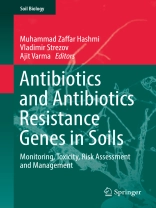This book summarizes the current state of knowledge regarding antibiotics and antibiotics resistance genes (ARGs) in the soil environment. It covers a wide range of topics to help readers understand antibiotics and ARGs in soils, the risks they pose for the environment, and options for effective control. In addition, it presents a range of essential tools and methodologies that can be used to address antibiotics and ARGs in a consistent, efficient, and cost-effective manner.
Gathering contributions by international experts, the book addresses both theoretical aspects and practical applications.The topics discussed include antibiotics-producing microorganisms; the routes of entry and fate of antibiotics and resistance genes; biomonitoring approaches; dissemination of ARGs in soils; risk assessment; the impact of antibiotics and ARGs on the soil microbial community and other biota; bioremediation and biodegradation approaches; and soil management strategies for antibiotics and ARG-contaminated soils.As such, the book will be of interest to students, researchers and scholars in environmental science and engineering, toxicology, the medical and pharmaceutical sciences, environmental biotechnology, soil sciences, microbial ecology and plant biotechnology.
Readers and Journals:
1. This new volume on antibiotics and antibiotics resistance genes (ARGs) in the soil environment will be of interest to students, researchers and scholars in environmental science and engineering, toxicology, the medical and pharmaceutical sciences, environmental biotechnology, soil sciences, microbial ecology and plant biotechnology.
2. The book will provide government authorities all over the world with effective strategies for the management of antibiotics and antibiotics resistance genes (ARG)- contaminated soil.
3. Gathering contributions by international experts, the book addresses both theoretical aspects and practical applications.Tabella dei contenuti
Chapter 1: Antibiotics Producing Soil Microorganisms.- Chapter 2: Antibiotics Resistance Genes.- Chapter 3: A review on antibiotics consumption, physio-chemical properties and their sources in Asian soil.- Chapter 4: Entry Routes of Veterinary Antibiotics in the Environment.- Chapter 5: Monitoring of Antibiotics and Antibiotic Resistance Genes in Agroecosystems.- Chapter 6: Role of Antibiotics in Climate Change.- Chapter 7: Potential dissemination of ARB and ARG into soil through the use of treated wastewater for agricultural irrigation –is it a true cause for concern?.- Chapter 8: Antibiotic Resistance Gene Due to Manure Application.- Chapter 9: Antibiotics and Antibiotics Resistance Genes dissemination in soils.- Chapter 10: Dissemination Mechanism of Antibiotic Resistance Genes in Environment.- Chapter 11: Fate of Antibiotics in Soil.- chapter 12: Uptake of Antibiotics by Plants.- Chapter 13: Recent advances in methods for the detection of antibiotics and antibiotics resistance genes in soil.- Chapter 14: Elucidation of emerging nanomaterialsimpacts on antibiotic resistance against soil and aquatic microflora.- Chapter 15: The Effects of Antibiotics on the Structure, Diversity and Function of a Soil Microbial Community.- Chapter 16: Soil antibiotics and transfer of antibiotic resistance genes affecting wildlife.- Chapter 17: Genotoxicity and Biochemical Toxicity of Soil Antibiotics to Earthworm.- Chapter 18: Potential Environmental, Ecological and Health Effects of Soil Antibiotics and ARGs.- Chapter 19: Risk Assessment of Antibiotics and Antibiotic Resistant Genes (ARGs) in soil.- Chapter 20: Antibiotics in the soil: sources, environmental issues and bioremediation.- chapter 21: Management and Regulation of Antibiotics and Antibiotics Resistance Genes in Soils.
Circa l’autore
Prof. Muhammad Zaffar Hashmi
Dr. Hashmi is Assistant Professor at the Department of Meteorology, COMSATS Institute of Information Technology, Islamabad, Pakistan. He completed his Ph D in Environmental Engineering at the Zhejiang University, China. Dr. Hashmi research focused on Bioremediation of contaminated soil and cell toxicology. His book: Xenobiotics in the Soil Environment published in Springer has been used at innumerable colleges, universities and research institutions all over the world.
Prof. Vladimir Strezov
Prof Strezov is Professor at the Department of Environmental Sciences, Faculty of Science and Engineering, Macquarie University, Australia. He completed his Ph D in Chemical Engineering at the University of Newcastle, Australia. Prof Strezov leads a research team who work on a range of topics that deal with reduction of environmental pollution of industrial activities. Prof Strezov is a Fellow of Engineers Australia, serves as Associate Editor for the Journal of Cleaner Production and is an editorial board on a number of journals and relevant conferences.
Prof. Ajit Varma
Ajit Varma (M.Sc., Ph.D.) was professor of microbial technology at the School of Life Sciences, Jawaharlal Nehru University, New Delhi, before he became Director of the AMITY Institute of Herbal & Microbial Research in 2004.
Professor Varma has won a large number of coveted national and international awards for his scientific contributions and was elected Fellow of the National Academy of Agricultural Sciences of India. He has lectured on various aspects of microbial sciences worldwide and has been honored for his excellence in teaching at esteemed universities.
His first two books, dealing with mycorrhizal research, were published in 1991-1992 by Academic Press (UK) and have been used at innumerable colleges, universities and research institutions all over the world. Since then, he has compiled 18 books produced by leading and prestigious scientific publishing houses.












